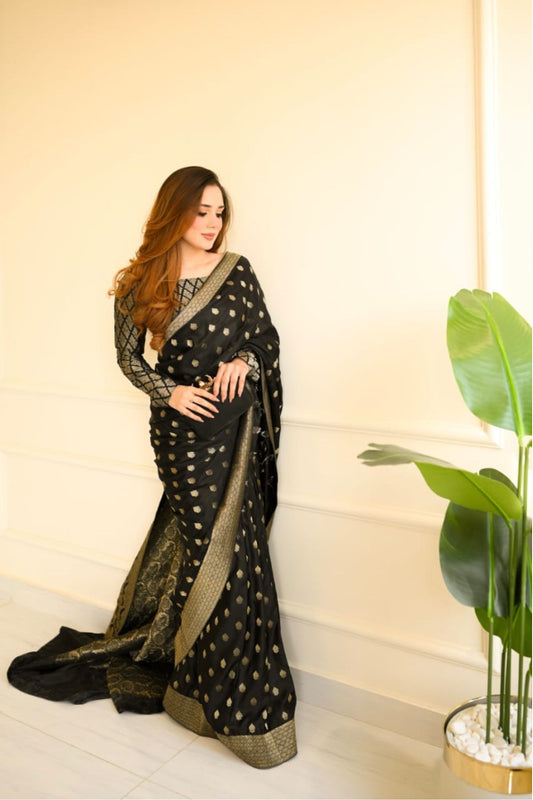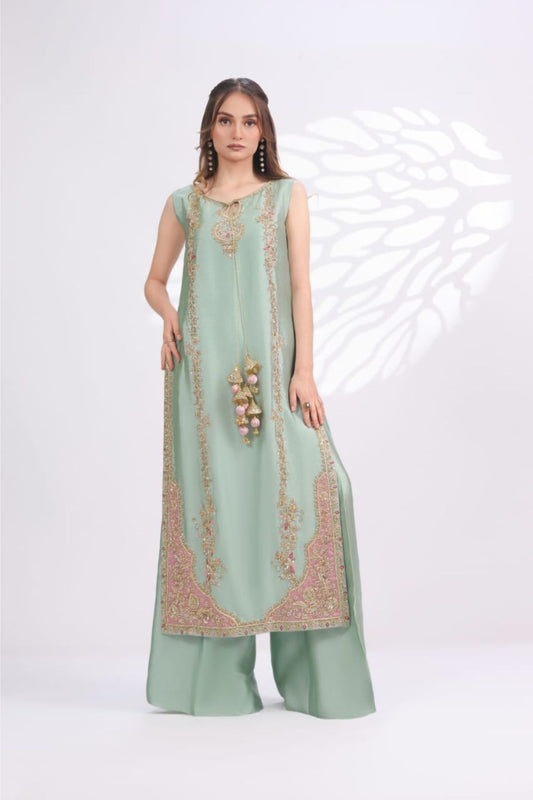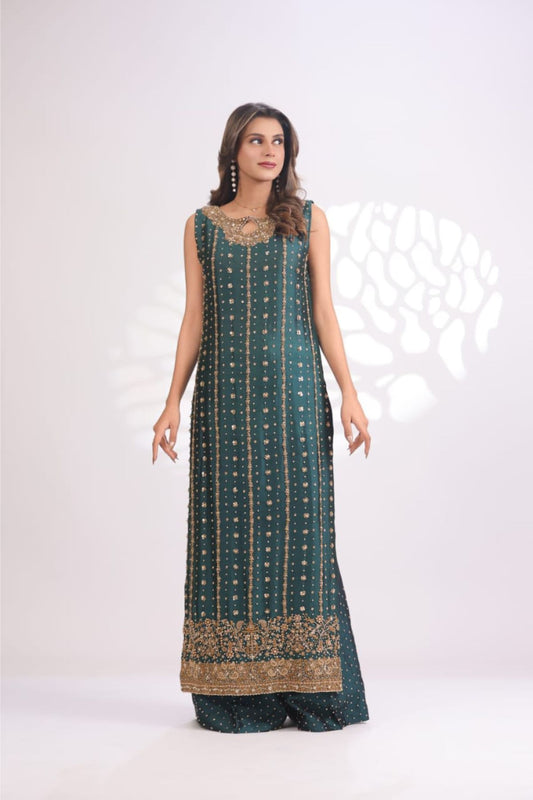Cultural Fusion: Pakistani Party Wear with a Modern Twist
Introduction
Pakistani fashion has always been known for its rich cultural heritage and the timeless elegance of traditional attire. However, in recent years, the fashion landscape in Pakistan has undergone a significant transformation. Modern fashion trends and global influences have started to merge with traditional Pakistani styles, resulting in a delightful fusion that's taking the party wear scene by storm. In this blog post, we'll explore how modern fashion trends are influencing Pakistani party wear and giving rise to fusion styles that are a perfect blend of old and new.
1. Contemporary Silhouettes with Traditional Embellishments
Contemporary fashion often draws inspiration from traditional styles and techniques, resulting in a harmonious fusion of old and new. In recent years, we've witnessed a trend where modern silhouettes, like peplum tops, capes, and crop blouses, are adorned with traditional embellishments such as intricate embroidery, zardozi work, and gota patti. This fusion of old-world charm and contemporary design creates stunning and unique pieces that capture the essence of both eras. Let's delve into how these traditional embellishments are integrated into modern silhouettes:
Peplum Tops with Intricate Embroidery:
- Peplum tops are known for their fitted bodices and flared waistline. These have been combined with traditional embroidery techniques to create a fusion of modern and classic elements. Intricate embroidery like zari, threadwork, or mirror work is applied to the peplum, often drawing inspiration from traditional motifs and patterns.
- The juxtaposition of the structured peplum silhouette with the opulent embroidery creates a visually captivating and elegant look. This blend of contemporary style with timeless craftsmanship appeals to those who appreciate both the modern and traditional aspects of fashion.
Capes with Zardozi and Gota Patti:
- Capes have gained popularity as a contemporary outerwear option. They can be short or long and are versatile additions to various outfits. To infuse a touch of tradition, capes are often adorned with zardozi work and gota patti.
- Zardozi is a classical Indian embroidery technique that uses metallic threads, while gota patti involves the use of metallic ribbons and appliqué work. When these techniques are incorporated into capes, they bring an element of regal opulence and a connection to India's rich heritage.
- The contrast between the free-flowing and often minimalistic cape design and the ornate zardozi and gota patti work creates a striking balance that embodies both modern sophistication and traditional craftsmanship.
Crop Blouses with Traditional Patterns:
- Crop blouses are a trendy choice for pairing with sarees, lehengas, or high-waisted skirts. They offer a contemporary twist on traditional Indian attire. These crop blouses can be adorned with traditional patterns, especially in the back designs and sleeves.
- Traditional motifs like paisley, lotus, or peacock designs are incorporated into the embroidery, creating a nostalgic connection to India's textile heritage. These patterns are often created using a combination of threadwork, sequins, and beads.
- The fusion of modern silhouettes with traditional patterns brings an element of cultural richness and storytelling to contemporary fashion. It's a way to pay homage to one's heritage while embracing current fashion trends.
2. Vibrant Colors Meet Minimalism
The marriage of vibrant and bold colors with minimalist design principles is a striking and intriguing trend in the world of Pakistani fashion. Pakistani fashion has long been celebrated for its use of vivid and rich color palettes, and the combination of these colors with minimalist designs allows the colors to take center stage while maintaining a contemporary and elegant aesthetic. Here's an exploration of this compelling fusion:

Use of Vibrant Colors:
- Vibrant colors are a hallmark of Pakistani fashion. This includes a wide range of hues such as deep reds, bright pinks, vivid oranges, and bold greens. These colors are deeply rooted in Pakistani culture and traditions, often symbolizing celebrations and festivities.
- Vibrant colors convey energy, exuberance, and a strong sense of identity. They make a powerful statement and have a cultural significance that's deeply ingrained in Pakistan's fashion heritage.
Minimalist Design Principles:
- Minimalism in fashion revolves around simplicity, clean lines, and an uncluttered aesthetic. It emphasizes the importance of form, texture, and color, often favoring less ornamentation and complexity.
- Minimalist designs offer a modern, sophisticated look, which stands in contrast to the traditional opulence seen in Pakistani fashion. The clean and unfussy lines of minimalism allow the focus to shift to color and fabric.
Color as the Centerpiece:
- The pairing of vibrant colors with minimalist designs places the spotlight firmly on the colors themselves. In such designs, the color becomes the most expressive and dominant element, commanding attention and exuding vitality.
- The use of vibrant colors in minimalist fashion is a way to celebrate and elevate the essence of these colors, allowing them to convey their cultural and emotional depth.
Contrast and Balance:
- The combination of vibrant colors with minimalist design creates a compelling visual contrast. The bold, intense colors play off the simplicity of the design, resulting in a balanced and visually striking ensemble.
- The restraint in design serves as a backdrop for the colors to shine, and in return, the colors enhance the minimalist elements, making them appear more pronounced and impactful.
Versatility and Wearability:
This fusion of vibrant colors with minimalist designs offers a wide range of versatility. The resulting outfits can be suitable for both formal and casual occasions. They appeal to those who appreciate the beauty of bold colors but also want an elegant, contemporary look.Cultural Preservation and Innovation:
By combining vibrant colors with minimalist designs, Pakistani fashion designers pay homage to their cultural heritage while embracing modernity. This fusion allows for the preservation of cultural symbols and traditional color palettes in a way that feels fresh and innovative.3. Fusion of Fabrics
The fusion of fabrics in traditional Pakistani party wear is a captivating trend that marries the rich and diverse textiles from different cultures and eras. This fusion often includes the incorporation of unconventional fabrics like denim, silk, and organza, resulting in a unique blend of textures and styles. Here's a closer look at how these fabrics are integrated into traditional Pakistani party wear:
Denim and Traditional Embroidery:
- Denim, typically considered a casual fabric, is being transformed into elegant party wear. Traditional Pakistani party attire often features intricate embroidery, which is skillfully applied to denim outfits. This fusion brings a contemporary edge to traditional embroidery styles.
- Denim's casual, rugged texture provides a striking contrast to the delicate and ornate traditional embroidery work, creating a balanced yet dynamic visual appeal.
Silk and Intricate Embellishments:
- Silk is a luxurious fabric known for its sheen, softness, and drape. In traditional Pakistani party wear, silk is often combined with intricate embellishments such as zari, gota patti, and beadwork.
- The fusion of silk with traditional embellishments elevates the fabric's elegance, making it ideal for special occasions. The interplay of lustrous silk and the detailed craftsmanship of traditional techniques produces stunning, high-impact outfits.
Organza and Traditional Prints:
- Organza, a sheer and lightweight fabric, has gained popularity in Pakistani party wear. It often serves as the canvas for traditional prints and motifs. This combination retains the ethereal quality of organza while infusing it with cultural richness.
- The use of traditional prints on organza allows for a captivating fusion of transparency and intricate patterns, creating a sense of depth and dimension in the outfit.
Texture and Layering:
- The fusion of different fabrics allows for creative layering in Pakistani party wear. For instance, a denim jacket with traditional embroidery can be layered over a silk or organza outfit. This juxtaposition of textures and styles results in outfits that are multi-dimensional and visually engaging.
- Layering also adds a contemporary edge to traditional attire, allowing wearers to experiment with their style while preserving cultural authenticity.
Versatility and Adaptability:
- The fusion of fabrics provides party wear with an added level of versatility. It allows individuals to tailor their outfits according to their personal preferences and the formality of the occasion. This adaptability ensures that traditional attire can be worn comfortably at various events.
- Unconventional fabric choices are not confined to any specific type of party wear. They can be seen in everything from bridal ensembles to formal gowns and everyday party wear, making them accessible and adaptable to diverse settings.
Cultural Exchange and Global Appeal:
The fusion of fabrics represents a cross-cultural exchange, where Western and Eastern elements come together. This mix of textures and styles broadens the appeal of traditional Pakistani party wear to a global audience, transcending boundaries and fostering appreciation for both cultures.
4. Mix and Match
Mixing and matching elements of Pakistani and Western attire is a fascinating fashion trend that reflects a fusion of diverse cultural influences. This trend allows individuals to create unique and personalized outfits by combining traditional Pakistani elements with contemporary Western styles. Here's an exploration of how this mix-and-match approach is redefining fashion:
Lehenga Skirt with a Contemporary Blouse:
- Combining a traditional lehenga skirt with a contemporary blouse is a prime example of this trend. The lehenga skirt is a quintessential piece of Pakistani bridal and formal wear, known for its opulent design and intricate embroidery. In contrast, a contemporary blouse can feature modern cuts, interesting necklines, and unconventional fabrics.
- This blend harmonizes the grandeur of Pakistani craftsmanship with Western design aesthetics. It creates a balanced and innovative look that is perfect for special occasions like weddings and festivals.
Shalwar Pants with a Chic Off-Shoulder Top:
- Pairing traditional shalwar pants with a chic off-shoulder top is another instance of mixing and matching. Shalwar pants, which are an integral part of Pakistani ethnic wear, are known for their comfort and versatility. In contrast, off-shoulder tops are a Western trend, valued for their contemporary style.
- This combination showcases the fusion of comfort with contemporary fashion. The elegance of shalwar pants is juxtaposed with the sensuous appeal of the off-shoulder top, creating a trendy yet culturally rooted ensemble.
Western Jacket with a Traditional Kurta:
- Donning a Western jacket over a traditional kurta is a versatile way to blend styles. The kurta, often made of vibrant and richly patterned fabrics, is a staple in Pakistani wardrobes. Pairing it with a Western jacket adds an element of sophistication and layering to the outfit.
- This mix-and-match approach brings together the comfort and grace of a kurta with the structured and chic look of a Western jacket, making it suitable for a range of settings, from casual gatherings to formal events.
Sari with a T-shirt or Tank Top:
- One of the most eclectic combinations is draping a sari with a T-shirt or tank top. The sari is a traditional Pakistani and Indian attire known for its grace and timelessness. When paired with a casual Western top, it transforms into a bold and contemporary ensemble.
- This fusion encapsulates the spirit of fusion fashion. It's a celebration of diverse cultures and styles, breaking away from conventions to create an outfit that's both visually captivating and comfortable.
Western Accessories with Traditional Attire:
- Another way to blend styles is by incorporating Western accessories with traditional Pakistani attire. For example, adding a statement Western belt to a traditional shalwar kameez or pairing traditional jewelry with Western clothing.
- This approach allows individuals to infuse their traditional attire with a modern and personal touch, making it a versatile and fashionable choice for various occasions.
5. Accessorizing with a Twist
Statement Earrings:
- Statement earrings are bold, eye-catching accessories that often feature intricate designs, bright colors, or oversized shapes. These can be paired with traditional Pakistani outfits like lehengas, anarkalis, or bridal wear.
- Statement earrings add drama and glamour to the overall look. They can complement or contrast the color scheme of the attire, enhancing the vibrancy of the ensemble.
- These earrings create a striking balance between the detailed craftsmanship of traditional attire and the contemporary allure of oversized, attention-grabbing accessories.
Contemporary Handbags:
- Contemporary handbags are modern and stylish alternatives to traditional clutches or potli bags. They often come in a wide range of materials, from leather and suede to acrylic and metals. These handbags are perfect for pairing with Pakistani outfits for a chic and modern look.
- The choice of handbag can add a pop of color, texture, or pattern to the ensemble. They serve a functional purpose while also being a fashionable accessory.
- The fusion of a contemporary handbag with traditional attire offers a harmonious blend of utility and style, demonstrating a balance between heritage and modernity.
Footwear and Ankle Accessories:
- Modern footwear, including strappy heels or stylish sneakers, can be paired with traditional Pakistani outfits, providing comfort and a contemporary twist.
- Ankle accessories like anklets or chain bracelets can be layered over traditional footwear like khussa or juttis, adding a touch of glamour and individuality to the overall look.
Sunglasses and Headbands:
- Sunglasses are not only a practical accessory but also a style statement. They can be paired with traditional attire for outdoor events or daytime occasions, adding a modern, trendy touch.
- Headbands are another accessory that's gaining popularity when combined with traditional Pakistani outfits. They can be embellished with beads, stones, or fabrics to match the outfit or provide a contrast.
6. Western Influences in Pakistani Bridal Wear:
In recent years, bridal wear in Pakistan has witnessed a notable influence from Western wedding fashion, with the incorporation of elements such as veils, trains, and ball gown silhouettes. While traditional Pakistani bridal attire has always been rich in cultural symbolism, there is a growing fascination with Western bridal aesthetics that has led to the adaptation of these features.
Veils, which were traditionally not an integral part of Pakistani bridal attire, have become a popular addition, often embellished with intricate embroidery to match the bridal ensemble. Similarly, the concept of a train, reminiscent of Western bridal gowns, has been introduced to elevate the grandeur of bridal outfits.
Ball gown silhouettes, characterized by voluminous skirts and fitted bodices, are also making their way into Pakistani bridal fashion, offering a contemporary alternative to the more traditional lehengas and shararas. This cross-cultural fusion reflects the ever-evolving nature of fashion, allowing brides in Pakistan to embrace a blend of cultural heritage and global trends, resulting in stunning, multifaceted bridal ensembles that captivate the imagination.
7. Celebrity Influences:
Pakistani celebrities are increasingly setting fashion trends by wholeheartedly embracing fusion styles in their party wear, profoundly influencing fashion trends and inspiring a wave of sartorial innovation. Their choices, often seen at red carpet events, award shows, or on social media platforms, showcase a dynamic blend of traditional Pakistani attire with contemporary Western elements.
This fusion could involve pairing a traditional kurta with jeans, experimenting with unconventional fabrics for shalwar kameez, or mixing bold accessories with classic attire. As trendsetters with a substantial following, these celebrities wield significant influence, encouraging fashion enthusiasts to explore the boundaries of cultural and global styles. Their bold and creative fashion choices open the door for the masses to experiment with fusion wear, bridging the gap between the old and the new, and contributing to the ever-evolving landscape of Pakistani fashion.
8. The Rise of Indo-Western Fusion:
The rise of Indo-Western fusion outfits is a testament to the dynamic evolution of fashion in Pakistan, reflecting a growing appreciation for cross-cultural influences. These fusion ensembles seamlessly blend elements from Indian and Western fashion with traditional Pakistani attire.
Whether it's the integration of Indian embroidery techniques, such as zari and gota patti, into shalwar kameez or the incorporation of Western silhouettes and fabrics like denim and organza into classic Pakistani designs, these outfits offer a fresh and versatile take on style.
The versatility and adaptability of Indo-Western fusion make it a hit among fashion-conscious individuals, enabling them to strike a harmonious balance between cultural heritage and contemporary trends, forging a captivating path forward in the world of Pakistani fashion.
Conclusion
The fusion of modern fashion trends with traditional Pakistani party wear has ushered in a new era of creativity and diversity in the fashion world. It's an exciting time for fashion enthusiasts who are open to experimenting with styles and for designers who continue to push the boundaries of traditional attire. This cultural fusion serves as a reminder that fashion is ever-evolving, and the beauty of fusion lies in its ability to blend the past and the present to create something uniquely stunning and contemporary.






